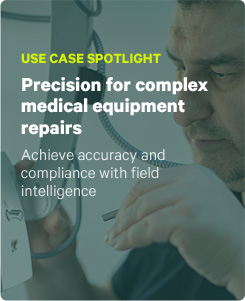
As mobile technology becomes more powerful, its deployment becomes more complex. Businesses are relying more and more on IT departments to support the evolution, but with the number of mobile devices and apps required for each business, the demand for IT resources has begun to outpace availability. The automation revolution has reached the field – and companies that have made the leap are improving service delivery, CSAT, sales, and cash flow. But with such a high demand on IT, they are turning increasingly to no-code platforms. These business-user-friendly platforms are empowering field technicians with powerful mobile apps to handle complex tasks reliably and with minimal training.
Though CRM, FSM, and EAM systems have existed in the back-office for decades in some form or another, enterprises are now realizing the mobile solutions promised by their existing solutions will never meet their needs. At the same time, IT teams have been overwhelmed by demands, and are not equipped to handle custom mobile application development to the scope and scale required to meet the volume of requests coming from every part of the business.
How, then, does an enterprise business with a complex list of needs – in the field and elsewhere – identify no-code solutions that improve field performance in a way that’s built for business users in mind? No-code app development platforms have stepped up to bridge the growing gap between supply and demand. When thinking no-code, though, it’s important to think field first – and here are five capabilities to consider.
Agile
You need to make changes to a process, but you don’t have time to print and distribute updated forms to the field. A no-code platform should allow you to quickly modify and publish process changes to thousands of users with just a few mouse clicks – and without the support of a dozen developers.
Mobile native
Work in the field is never easy: whether there’s inclement weather, or they’re in the middle of the ocean, it’s imperative that your apps function offline. And not just the bare bones – they should be fully functional, including hosted data sets and lookup features.
DIY-friendly
Systems of record often provide a mobile app that supports an integration to their own platform and nothing else, but your business needs so much more. Your no-code platform should allow you to customize the flow of data to suit you, not force you to build your workflow to accommodate them.
Beautifully branded
Whether your solution is customer-facing, or employees’ eyes only, you want it to look good. The ability to brand your no-code solution ensures scalability across departments and use cases, from performing service on the app, to sending beautiful documents to customers.
Solution-focused
The best field-focused platforms don’t support databases, and for good reason. You already have a back-office system (or systems) of record that meets your data storage policies, so why make things complicated? A no-code field solution should be a conduit for data flowing from the field into the back-office systems you already know and trust.
Conclusion
There are high stakes for choosing a no-code mobile platform. Enterprise businesses require a robust developer tool set and the ability to utilize API connections, powerful automated app and user governance, and a pedigree of working with global brands who’ve deployed the solution for mission-critical processes.
At the end of the day, though, many deployments have failed or succeeded because of how much consideration those in charge gave the interaction between the back-office that would be deploying the solution, and the field where the solution would be deployed. The waters of no-code platforms are deep and complex, so learn from those who’ve sailed them before. When evaluating no-code platforms, take five and be sure to consider not only why you’re looking at them – but for who.
Want to learn more about how mobile technology is changing the way businesses operate? Join ProntoForms’ CEO and Founder Alvaro Pombo on January 31st, 2019 as he discusses the leading edge of mobile technology in a free webinar.




